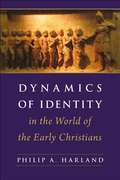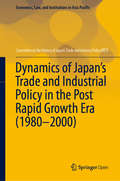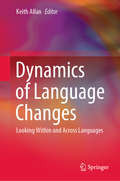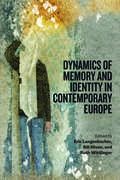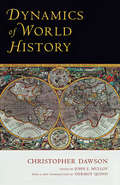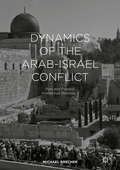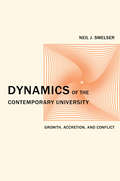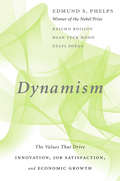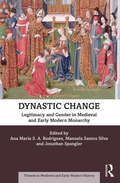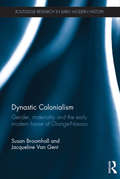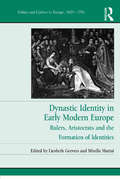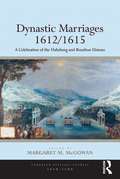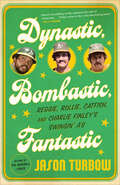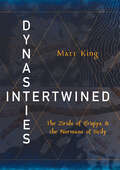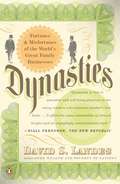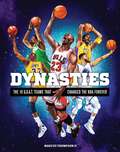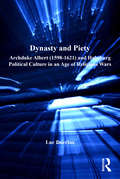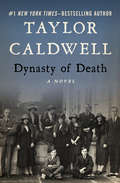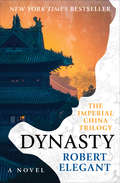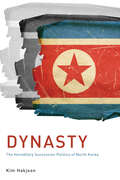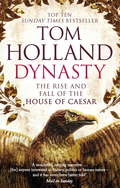- Table View
- List View
Dynamics of Identity in the World of the Early Christians
by Philip A. HarlandThis study sheds new light on identity formation and maintenance in the world of the early Christians by drawing on neglected archaeological and epigraphic evidence concerning associations and immigrant groups and by incorporating insights from the social sciences. The study's unique contribution relates, in part, to its interdisciplinary character, standing at the intersection of Christian Origins, Jewish Studies, Classical Studies, and the Social Sciences. It also breaks new ground in its thoroughly comparative framework, giving the Greek and Roman evidence its due, not as mere background but as an integral factor in understanding dynamics of identity among early Christians. This makes the work particularly well suited as a text for courses that aim to understand early Christian groups and literature, including the New Testament, in relation to their Greek, Roman, and Judean contexts. Inscriptions pertaining to associations provide a new angle of vision on the ways in which members in Christian congregations and Jewish synagogues experienced belonging and expressed their identities within the Greco-Roman world. The many other groups of immigrants throughout the cities of the empire provide a particularly appropriate framework for understanding both synagogues of Judeans and groups of Jesus-followers as minority cultural groups in these same contexts. Moreover, there were both shared means of expressing identity (including fictive familial metaphors) and peculiarities in the case of both Jews and Christians as minority cultural groups, who (like other . foreigners. ) were sometimes characterized as dangerous, alien . anti-associations. . By paying close attention to dynamics of identity and belonging within associations and cultural minority groups, we can gain new insights into Pauline, Johannine, and other early Christian communities.
Dynamics of Japan’s Trade and Industrial Policy in the Post Rapid Growth Era (Economics, Law, and Institutions in Asia Pacific)
by RIETIThis open access book provides an in-depth examination of Japan's policy responses to the economic challenges of the 1980s and '90s. While MITI's earlier role in promoting rapid growth has been addressed in other studies, this volume, based on official records and exhaustive interviews, is the first to examine the aftermath of rapid growth and the evolution of MITI's interpretation of the economy's changing needs. Covering such topics as the oil shocks, trade conflict with the United States, and the rise and collapse of the so-called bubble economy, it presents a detailed analysis and evaluation of how these challenges were interpreted by government officials, the kinds of policies that were enacted, the extent to which policy aims were realized, and lessons for the longer term. This book is recommended especially to officials of countries concerned about the challenges that follow on high economic growth and to readers interested in Japan’s contemporary economic history.
Dynamics of Language Changes: Looking Within and Across Languages
by Keith AllanThis book explores the dynamics of language changes from sociolinguistic and historical linguistic perspectives. With in-depth case studies from all around the world, it uses diverse approaches across sociolinguistics and historical linguistics to answer questions such as: How and why do language changes begin?; how do language changes spread?; and how can they ultimately be explained?Each chapter explores a different component of language change, including typology, syntax, morphology, phonology, semantics, lexicology, discourse strategies, diachronic change, synchronic change, how the deafblind modify sign language, and the accommodation of language to song. This book presents a comprehensive analysis of the dynamics of language change over time, simultaneously advancing current research and suggesting new directions in sociolinguistic and historical linguistic approaches.
Dynamics of Memory and Identity in Contemporary Europe
by Niven Langenbacher WittlingerThe collapse of the Iron Curtain, the renationalization of eastern Europe, and the simultaneous eastward expansion of the European Union have all impacted the way the past is remembered in today's eastern Europe. At the same time, in recent years, the Europeanization of Holocaust memory and a growing sense of the need to stage a more "self-critical" memory has significantly changed the way in which western Europe commemorates and memorializes the past. The increasing dissatisfaction among scholars with the blanket, undifferentiated use of the term "collective memory" is evolving in new directions. This volume brings the tension into focus while addressing the state of memory theory itself.
Dynamics of Spiritual Life: An Evangelical Theology of Renewal
by Richard F. LovelaceIn this classic work of spiritual theology, historian Richard Lovelace presents a history of spiritual renewals in light of biblical models.Dynamics of Spiritual Life
Dynamics of World History
by Christopher DawsonIn scope and in vision Christopher Dawson&’s historiography ranks with the work of men like Spengler, Northrop, and Toynbee. Several major themes run through Dawson&’s work, but perhaps his most unique contribution was his insistence on the importance of religion in shaping and sustaining civilizations.Religion, Dawson believed, is the great creative force in any culture, and the loss of a society&’s historic religion therefore portends a process of social dissolution. For this reason, Dawson concluded that Western society must find a way to revitalize its spiritual life if it is to avoid irreversible decay. Progress, the real religion of modernity, is insufficient to sustain cultural health. And an ahistorical, secularized Christianity is an oxymoron, a pseudo-religion only nominally related to the historic religion of the West.Dawson maintained that the hope of the present age lay in the reconciliation of the religious tradition of Christianity with the intellectual tradition of humanism and the new knowledge about man and nature provided by modern science. Dynamics of World History shows that though such a task may be difficult, it is not impossible.
Dynamics of the Arab-Israel Conflict
by Michael BrecherThis book comprises findings from the author's wide-ranging research since 1948 on the unresolved Arab/Israel protracted conflict. Brecher reflects back on his detailed analysis of the UN Commisssion created in November 1947, and his near-seven decades of research and publications on this complex protracted conflict continued since the first of nine Arab/Israeli wars. The book includes an analysis of the crucial early phase of the unresolved struggle for control of Jerusalem in 1948-49 and beyond, based on extensive interviews with Israel's leaders and prominent Egyptian senior officials, journalists and academics. It addresses the many diverse attempts at conflict resolution, including a peace plan to resolve the Arab/Israel conflict of the author's own design. It concludes with historical reflections about Israel's behavior, domestically and externally, in 1948-1949 and 2008 and beyond. No other book on this protracted conflict contains so many important interviews with the first two generations of Israeli leaders and Egyptian officials and academics, and no other author can speak from such a deep and prolonged engagement.
Dynamics of the Contemporary University
by Neil J. SmelserThis book is an expanded version of the Clark Kerr Lectures of 2012, delivered by Neil Smelser at the University of California at Berkeley in January and February of that year. The initial exposition is of a theory of change--labeled structural accretion--that has characterized the history of American higher education, mainly (but not exclusively) of universities. The essence of the theory is that institutions of higher education progressively add functions, structures, and constituencies as they grow, but seldom shed them, yielding increasingly complex structures. The first two lectures trace the multiple ramifications of this principle into other arenas, including the essence of complexity in the academic setting, the solidification of academic disciplines and departments, changes in faculty roles and the academic community, the growth of political constituencies, academic administration and governance, and academic stratification by prestige. In closing, Smelser analyzes a number of contemporary trends and problems that are superimposed on the already-complex structures of higher education, such as the diminishing public support without alterations of governance and accountability, the increasing pattern of commercialization in higher education, the growth of distance-learning and for-profit institutions, and the spectacular growth of temporary and part-time faculty.
Dynamis: Ontology of the Incommensurable (Contributions to Hermeneutics #9)
by Gaetano ChiurazziThis book offers a new and original hypothesis on the origin of modal ontology, whose roots can be traced back to the mathematical debate about incommensurable magnitudes, which forms the implicit background for Plato’s later dialogues and culminates in the definition of being as dynamis in the Sophist. Incommensurable magnitudes – also called dynameis by Theaetetus – are presented as the solution to the problem of non-being and serve as the cornerstone for a philosophy of difference and becoming. This shift also marks the passage to another form of rationality – one not of the measure, but of the mediation. The book argues that the ontology and the rationality which arise out of the discovery of incommensurable constitutes a thread that runs through the entire history of philosophy, one that leads to Kantian transcendentalism and to the philosophies derived from it, such as Hegelianism and philosophical hermeneutics.Readers discover an insightful exchange with some of the most important issues in philosophy, newly reconsidered from the point of view of an ontology of the incommensurable. These issues include the infinite, the continuum, existence, and difference. This text appeals to students and researchers in the fields of ancient philosophy, German idealism, philosophical hermeneutics and the history of mathematics.
Dynamism: The Values That Drive Innovation, Job Satisfaction, and Economic Growth
by Edmund S. Phelps Gylfi Zoega Raicho Bojilov Hian Teck HoonNobel Laureate Edmund Phelps and an international group of economists argue that economic health depends on the widespread presence of certain values, in particular individualism and self-expression. Nobel Laureate Edmund Phelps has long argued that the high level of innovation in the lead nations of the West was never a result of scientific discoveries plus entrepreneurship, as Schumpeter thought. Rather, modern values—particularly the individualism, vitalism, and self-expression prevailing among the people—fueled the dynamism needed for widespread, indigenous innovation. Yet finding links between nations’ values and their dynamism was a daunting task. Now, in Dynamism, Phelps and a trio of coauthors take it on. Phelps, Raicho Bojilov, Hian Teck Hoon, and Gylfi Zoega find evidence that differences in nations’ values matter—and quite a lot. It is no accident that the most innovative countries in the West were rich in values fueling dynamism. Nor is it an accident that economic dynamism in the United States, Britain, and France has suffered as state-centered and communitarian values have moved to the fore. The authors lay out their argument in three parts. In the first two, they extract from productivity data time series on indigenous innovation, then test the thesis on the link between values and innovation to find which values are positively and which are negatively linked. In the third part, they consider the effects of robots on innovation and wages, arguing that, even though many workers may be replaced rather than helped by robots, the long-term effects may be better than we have feared. Itself a significant display of creativity and innovation, Dynamism will stand as a key statement of the cultural preconditions for a healthy society and rewarding work.
Dynastic Change: Legitimacy and Gender in Medieval and Early Modern Monarchy (Themes in Medieval and Early Modern History)
by Ana Maria S. A. Rodrigues Manuela Santos Silva Jonathan W. SpanglerDynastic Change: Legitimacy and Gender in Medieval and Early Modern Monarchy examines the strategies for change and legitimacy in monarchies in the medieval and early modern eras. Taking a broadly comparative approach, Dynastic Change explores the mechanisms employed as well as theoretical and practical approaches to monarchical legitimisation. The book answers the question of how monarchical families reacted, adjusted or strategised when faced with dynastic crises of various kinds, such as a lack of a male heir or unfitness of a reigning monarch for rule, through the consideration of such themes as the role of royal women, the uses of the arts for representational and propaganda purposes and the impact of religion or popular will. Broad in both chronological and geographical scope, chapters discuss examples from the 9th to the 18th centuries across such places as Morocco, Byzantium, Portugal, Russia and Western Europe, showing readers how cultural, religious and political differences across countries and time periods affected dynastic relations. Bringing together gender, monarchy and dynasticism, the book highlights parallels across time and place, encouraging a new approach to monarchy studies. It is the perfect collection for students and researchers of medieval and early modern monarchy and gender.
Dynastic Colonialism: Gender, Materiality and the Early Modern House of Orange-Nassau
by Susan Broomhall Jacqueline Van GentDynastic Colonialism analyses how women and men employed objects in particular places across the world during the early modern period in order to achieve the remarkable expansion of the House of Orange-Nassau. Susan Broomhall and Jacqueline Van Gent explore how the House emerged as a leading force during a period in which the Dutch accrued one of the greatest seaborne empires. Using the concept of dynastic colonialism, they explore strategic behaviours undertaken on behalf of the House of Orange-Nassau, through material culture in a variety of sites of interpretation from palaces and gardens to prints and teapots, in Europe and beyond. Using over 140 carefully selected images, the authors consider a wide range of visual, material and textual sources including portraits, glassware, tiles, letters, architecture and global spaces in order to rethink dynastic power and identity in gendered terms. Through the House of Orange-Nassau, Broomhall and Van Gent demonstrate how dynasties could assert status and power by enacting a range of colonising strategies. Dynastic Colonialism offers an exciting new interpretation of the complex story of the House of Orange-Nassau‘s rise to power in the early modern period through material means that will make fascinating reading for students and scholars of early modern European history, material culture, and gender. This book is highly illustrated throughout. The print edition features the images in black and white, whereas the eBook edition contains the illustrations in colour.
Dynastic Identity in Early Modern Europe: Rulers, Aristocrats and the Formation of Identities (Politics and Culture in Europe, 1650-1750)
by Liesbeth Geevers Mirella MariniAristocratic dynasties have long been regarded as fundamental to the development of early modern society and government. Yet recent work by political historians has increasingly questioned the dominant role of ruling families in state formation, underlining instead the continued importance and independence of individuals. In order to take a fresh look at the subject, this volume provides a broad discussion on the formation of dynastic identities in relationship to the lineage’s own history, other families within the social elite, and the ruling dynasty. Individual chapters consider the dynastic identity of a wide range of European aristocratic families including the CroÃs, Arenbergs and Nassaus from the Netherlands; the Guises-Lorraine of France; the Sandoval-Lerma in Spain; the Farnese in Italy; together with other lineages from Ireland, Sweden and the Austrian Habsburg monarchy. Tied in with this broad international focus, the volume addressed a variety of related themes, including the expression of ambitions and aspirations through family history; the social and cultural means employed to enhance status; the legal, religious and political attitude toward sovereigns; the role of women in the formation and reproduction of (composite) dynastic identities; and the transition of aristocratic dynasties to royal dynasties. In so doing the collection provides a platform for looking again at dynastic identity in early modern Europe, and reveals how it was a compound of political, religious, social, cultural, historical and individual attitudes.
Dynastic Marriages 1612/1615: A Celebration of the Habsburg and Bourbon Unions (European Festival Studies: 1450-1700)
by Margaret M. McGowanThe union of the two royal houses - the Habsburgs and the Bourbons - in the early seventeenth century illustrates the extent to which marriage was a tool of government in Renaissance Europe, and festivals a manifestation of power and cultural superiority. With contributions from scholars representing a range of disciplines, this volume provides an all-round view of the sequence of festivals and events surrounding the dynastic marriages which were agreed upon in 1612 but not celebrated until 1615 owing to the constant interruption of festivities by protestant uprisings. The occasion inspired an extraordinary range of records from exchanges of political pamphlets, descriptions of festivities, visual materials, the music of songs and ballets, and the impressions of witnesses and participants. The study of these remarkable sources shows how a team of scholars from diverse disciplines can bring into focus again the creative genius of artists: painters, architects and costume designers, musicians and poets, experts in equestrianism, in pyrotechnics, and in the use of symbolic languages. Their artistic efforts were staged against a background of intense political diplomacy and continuing civil strife; and yet, the determination of Marie de Médicis and her advisers and of the Duke of Lerma brought to a triumphant conclusion negotiations and spectacular commemorations whose legacy was to inform festival art throughout European courts for decades. In addition to printed and manuscript sources, the volume identifies ways of giving future researchers access to festival texts and studies through digitization, making the book both an in-depth analysis of a particular occasion and a blueprint for future engagement with digital festival resources.
Dynastic, Bombastic, Fantastic: Reggie, Rollie, Catfish, and Charlie Finley's Swingin' A's
by Jason Turbow“An exciting and engrossing book. . . . will engage fans of Charlie O. Finley and the Oakland Athletics, along with anyone captivated by baseball history.” —Library Journal, starred review The Oakland A’s of the early 1970s: Never before had an entire organization so collectively traumatized baseball’s establishment with its outlandish behavior and business decisions. The high drama that played out on the field—five straight division titles and three straight championships—was exceeded only by the drama in the clubhouse and front office.Under the visionary leadership of owner Charles O. Finley, the team assembled such luminary figures as Reggie Jackson, Catfish Hunter, Rollie Fingers, and Vida Blue, and with garish uniforms and revolutionary facial hair, knocked baseball into the modern age. Finley’s need for control—he was his own general manager and dictated everything from the ballpark organist’s playlist to the menu for the media lounge—made him ill-suited for the advent of free agency. Within two years, his dynasty was lost.A history of one of the game’s most unforgettable teams, Dynastic, Bombastic, Fantastic is a paean to the sport’s most turbulent, magical team, during one of major league baseball’s most turbulent, magical times.“Masterfully recounts a thrilling period in Oakland A’s history.” —Billy Beane, executive vice president of baseball operations, Oakland A’s“Not to be believed, and yet 100 percent true.” —Steve Fainaru, senior writer for ESPN and author of League of Denial “A must-read for any fan of the sport.” —Chris Ballard, Sports Illustrated senior writer and author of One Shot at Forever“Carefully researched and often hilarious.” —San Francisco Chronicle“A chance to relive a period of outlandish moments in America’s pastime.” —Publishers Weekly
Dynasties Intertwined: The Zirids of Ifriqiya and the Normans of Sicily (Medieval Societies, Religions, and Cultures)
by Matt KingDynasties Intertwined traces the turbulent relationship between the Zirids of Ifriqiya and the Normans of Sicily during the eleventh and twelfth centuries. In doing so, it reveals the complex web of economic, political, cultural, and military connections that linked the two dynasties to each other and to other polities across the medieval Mediterranean. Furthermore, despite the contemporary interfaith holy wars happening around the Zirids and Normans, their relationship was never governed by an overarching ideology like jihad or crusade. Instead, both dynasties pursued policies that they thought would expand their power and wealth, either through collaboration or conflict. The relationship between the Zirids and Normans ultimately came to a violent end in the 1140s, when a devastating drought crippled Ifriqiya. The Normans seized this opportunity to conquer lands across the Ifriqiyan coast, bringing an end to the Zirid dynasty and forming the Norman kingdom of Africa, which persisted until the Almohad conquest of Mahdia in 1160.Previous scholarship on medieval North Africa during the reign of the Zirids has depicted the region as one of instability and political anarchy that rendered local lords powerless in the face of foreign conquest. Matt King shows that, to the contrary, the Zirids and other local lords in Ifriqiya were integral parts of the far-reaching political and economic networks across the Mediterranean. Despite the eventual collapse of the Zirid dynasty at the hands of the Normans, Dynasties Intertwined makes clear that its emirs were active and consequential Mediterranean players for much of the eleventh and twelfth centuries, with political agency independent of their Christian neighbors across the Strait of Sicily.
Dynasties: Fortunes and Misfortunes of the World's Great Family Businesses
by David S. LandesThrough perseverance, solid ingenuity, and unwavering determination, family-run companies-dynasties-have dominated wealth and business throughout the last two centuries. One third of Fortune 500 firms are family owned and, in most cases, the ideal of the family business is one synonymous with continuity, watchful leadership, and dedication to success. But what happens when bad behavior, extravagance, and laziness-all very real enemies of industry-are allowed to proliferate?
Dynasties: The 10 G.O.A.T. Teams That Changed the NBA Forever
by Marcus Thompson IIAcclaimed sports journalist Marcus Thompson explores the 10 teams that transformed basketball in this illustrated history of the sport.What turns a winning team into a dynasty? According to many, legitimate dynasties are teams that not only won two or more titles but combine personality, superstar talent, and consistent winning seasons. They are teams that you either love or love to hate.While basketball dynasties have been talked about in sports media circles-especially over the last few months-there isn't been a book that explores these top teams in basketball history. Dynasties features 10 winning teams that redefined the sport in their own way. Organized by dynasty beginning with the Minnesota Lakers (1948-1954) and ending with the Warriors (2015-the present), the book tells the story of each team with player and coach profiles (including some of the sports all-time greats: Johnson, Bird, Jordan, Abdul-Jabbar, O'Neal, Curry), key games, playing styles and tactics, controversies, and more. Also featured are teams and players that were frequent rivals to dynasty teams (such as LeBron James and the Cleveland Cavaliers), teams that could have been dynasties, and possible future dynasties.
Dynasty Divided: A Family History of Russian and Ukrainian Nationalism (NIU Series in Slavic, East European, and Eurasian Studies)
by Fabian BaumannWinner of the W. Bruce Lincoln Book PrizeDynasty Divided uses the story of a prominent Kievan family of journalists, scholars, and politicians to analyze the emergence of rivaling nationalisms in nineteenth-century Ukraine, the most pivotal borderland of the Russian Empire. The Shul'gins identified as Russians and defended the tsarist autocracy; the Shul'hyns identified as Ukrainians and supported peasant-oriented socialism. Fabian Baumann shows how these men and women consciously chose a political position and only then began their self-fashioning as members of a national community, defying the notion of nationalism as a direct consequence of ethnicity.Baumann asks what made individuals into determined nationalists in the first place, revealing the close link to private lives, including intimate family dramas and scandals. He looks at how nationalism emerged from domestic spaces, and how women played an important (if often invisible) role in fin-de-siècle politics. Dynasty Divided explains how nineteenth-century Kievans cultivated their national self-images and how, by the twentieth century, Ukraine steered away from Russia. The two branches of this family of Russian nationalists and Ukrainian nationalists epitomize the struggles for modern Ukraine.
Dynasty and Piety: Archduke Albert (1598-1621) and Habsburg Political Culture in an Age of Religious Wars
by Luc DuerlooThe youngest son of Emperor Maximilian II, and nephew of Philip II of Spain, Archduke Albert (1559-1621) was originally destined for the church. However, dynastic imperatives decided otherwise and in 1598, upon his marriage to Philip's daughter, the Infanta Isabella Clara Eugenia, he found himself ruler of the Habsburg Netherlands, one of the most dynamic yet politically unstable territories in early-modern Europe. Through an investigation of Albert's reign, this book offers a new and fuller understanding of international events of the time, and the Habsburg role in them. Drawing on a wide range of archival and visual material, the resulting study of Habsburg political culture demonstrates the large degree of autonomy enjoyed by the archducal regime, which allowed Albert and his entourage to exert a decisive influence on several crucial events: preparing the ground for the Anglo-Spanish peace of 1604 by the immediate recognition of King James, clearing the way for the Twelve Years' Truce by conditionally accepting the independence of the United Provinces, reasserting Habsburg influence in the Rhineland by the armed intervention of 1614 and devising the terms of the Oñate Treaty of 1617. In doing so the book shows how they sought to initiate a realistic policy of consolidation benefiting the Spanish Monarchy and the House of Habsburg. Whilst previous work on the subject has tended to concentrate on either the relationship between Spain and the Netherlands or between Spain and the Empire, this book offers a far deeper and much more nuanced insight in how the House of Habsburg functioned as a dynasty during these critical years of increasing religious tensions. Based on extensive research in the archives left by the archducal regime and its diplomatic partners or rivals, it bridges the gap between the reigns of Philip II and Philip IV and puts research into the period onto a fascinating new basis.
Dynasty in Motion: Wedding Journeys in Late Medieval and Early Modern Europe (Themes in Medieval and Early Modern History)
by Patrik PastrnakBringing together a variety of evidence, such as princely correspondence, travelogues, financial accounts, chronicles, chivalric or Renaissance poems, this book examines marital travels of princely brides and grooms on a comparative trans-European scale. This book argues that these journeys were extraordinary events and were instrumental for dynastical and monarchical self-representation, and channelled aspirations and anxieties of princely houses when facing each other. Each such journey was a little earthquake that resonated across all layers of society. Hundreds of diplomats, envoys, aristocrats, city officials, low-status personnel, soldiers, artists, musicians, poets, and humanists were involved in preparing, executing, and commemorating them. Stretching far beyond the mere physical movements of the future royal spouse, the journeys snowballed into a myriad of other meanings that epitomised the very character of a society based on prestige, magnificence, honour, and glory. The story of nuptial travelling is fascinating and rich; it is a perfect condensation of monarchical order, dynastic agenda, value system, personal motives, female agency, and social networks in this period. It is dynasty in motion, prestige on wheels, queenly time, place, and time like no other. This volume is the perfect resource for upper-level students and scholars of court studies, the history of monarchy, and for those interested in premodern Europe.
Dynasty of Death: A Novel (The Barbours and Bouchards Series #1)
by Taylor CaldwellTwo families grow a small munitions factory into a global empire in this saga by a New York Times–bestselling author spanning from 1837 to the eve of World War I. In 1837, Joseph Barbour, an upper servant in an English village, immigrates with his family to America so he can make his fortune in the nascent artillery business. A man of vision, Joseph foresees a time when wars will not be won with courage and brave hearts but rather by the nations with superior firearms. Joseph and his family settle in a rural Pennsylvania village, but his wife, Hilda, is unhappy and longs to return to England. Their shy and sensitive younger son, Martin, is also homesick, but what troubles him most is the cruelty and violence he sees in his older brother, Ernest. Martin&’s fears come to fruition when Joseph forms a gunpowder firm with Armand Bouchard, who lives with his wife and three sons down the road from the Barbours. As the years pass, Ernest proves himself invaluable to Barbour & Bouchard. Ruthless and ambitious, he takes what he wants. But beautiful Amy Drumhill continues to elude him and becomes the catalyst in a war that will estrange the two brothers and leave Ernest haunted by the blood that will be forever on his hands. Dynasty of Death is a moving saga of two families, the epic struggle between two brothers, and the legacy their guns will leave the world as mighty enemy nations gear up for battle.
Dynasty: A Novel (The Imperial China Trilogy #3)
by Robert ElegantNew York Times Bestseller: An epic of love and adultery, money and power, set amid the revolutionary turbulence of twentieth-century China, from the author of Manchu and Mandarin. Founder of the Sekloong dynasty of Hong Kong, Sir Jonathan, the illegitimate offspring of an Irish adventurer and his Chinese mistress, overcame colonial prejudice to build a vast and influential trading empire spanning half a century. The marriage of Sir Jonathan&’s profligate son Charles to the ambitious and beautiful Mary Osgood comes to embody, on both personal and political levels, the tensions between Orient and Occident, and between Nationalists and Communists fighting for control of postimperial China. Dynasty follows the Sekloongs&’ triumphs, tragedies, betrayals, and bloodshed through the decades as they expand and protect their own empire, even as their homeland is torn apart from within by war and ideological upheaval, from the fall of the last emperor to the triumph of Mao Tse-tung. As China turbulently enters the modern world, the Sekloongs also grow in stature and strength—as do their desires and wayward passions. Fluent in Mandarin, author Robert Elegant spent many years in Hong Kong as a journalist and commentator, and has authored many acclaimed books on China. His stirring drama combines vivid writing with a deep understanding of Chinese culture, creating &“an action-packed novel . . . conjured up with perception and vigor&” (TheNew York Times Book Review).
Dynasty: The Hereditary Succession Politics of North Korea
by Hakjoon KimScholar and senior journalist Kim Hakjoon provides a timely analysis of the rise of the Kim Il Sung family dynasty and the politics of leadership succession in Pyongyang, including Kim Jong Il's death and the advent of his son Kim Jong Un. Drawing on official North Korean statements and leaked confidential documents, journalistic accounts, and defector reports, the book synthesizes virtually all that is known about the secretive family and how it operates within a bizarre governing system. Particularly valuable for a Western audience is the author's extensive use of South Korean studies of the Kim family, many of which have not been translated into English. Dynasty is insightful reading for officials, journalists, scholars, and students interested in the Korean Peninsula and its prospects.
Dynasty: The Rise and Fall of the House of Caesar
by Tom Holland'This is a wonderful, surging narrative - a brilliant and meticulous synthesis of the ancient sources . . . This is a story that should be read by anyone interested in history, politics or human nature - and it has never been better told' - Boris Johnson, Mail on SundayRome was first ruled by kings, then became a republic. But in the end, after conquering the world, the Republic collapsed. Rome was drowned in blood. So terrible were the civil wars that the Roman people finally came to welcome the rule of an autocrat who could give them peace. 'Augustus,' their new master called himself: 'The Divinely Favoured One'.The lurid glamour of the dynasty founded by Augustus has never faded. No other family can compare for sheer unsettling fascination with its gallery of leading characters. Tiberius, the great general who ended up a bitter recluse, notorious for his perversions; Caligula, the master of cruelty and humiliation who rode his chariot across the sea; Agrippina, the mother of Nero, manoeuvering to bring to power the son who would end up having her murdered; Nero himself, racing in the Olympics, marrying a eunuch, and building a pleasure palace over the fire-gutted centre of his capital.Now, in the sequel to Rubicon, Tom Holland gives a dazzling portrait of Rome's first imperial dynasty. Dynasty traces the full astonishing story of its rule of the world: both the brilliance of its allure, and the blood-steeped shadows cast by its crimes. Ranging from the great capital rebuilt in marble by Augustus to the dank and barbarian-haunted forests of Germany, it is populated by a spectacular cast: murderers and metrosexuals, adulterers and druids, scheming grandmothers and reluctant gladiators. Dynasty is the portrait of a family that transformed and stupefied Rome.
